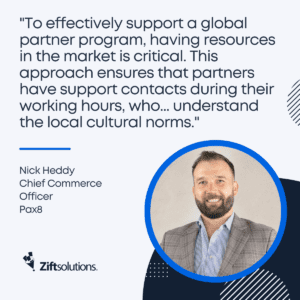- Global partner programs need to have local points of contact.
- Global partner programs should customize initiatives to each region.
- Global partner programs should pay attention to and accommodate cultural differences.
- Global partner programs need to be mindful of regional regulations and laws.
- Global partner programs can lean on distributors as appropriate to help reach partners in new regions.
- Global partner programs can recruit partners through the same methods in each region.
- Global partner programs need to establish a single source of truth for global program alignment.
7 Best Practices in Managing Global Partner Programs
A global partner program can be a doorway to scalability and rapid growth for channel organizations in 2023 and beyond. Just take it from these channel experts:
- “It only makes sense for programs to expand globally,” says Chris Walker, Marketing Manager for cloud-first WAN and security company Aryaka Networks. “A global program means exposure to new markets and partners (e.g., new partner size, partner type and solution preference). This leads to increased revenue, especially if a program can focus on being a fast-mover in an emerging market with room for an early presence in the region.”
- “As companies and solutions grow, their involvement with firms and people beyond their own countries does as well,” says Tina Gravel, Vice President, Global Head of Channel Sales for global contextual decision intelligence solutions provider Quantexa. “The world continues to get smaller with regard to acceptance and use of software and services around the world. For example, with software as a service, cloud as a service, etc., one no longer needs to be in close proximity with providers of technology to offer the brand or solution.”
- “In 2021, Pax8 expanded globally with the launch of our first international office in the U.K.,” says Nick Heddy, Chief Commerce Officer for cloud commerce marketplace Pax8. “In the three years since our UK launch, we have grown the market significantly and exceeded our expectations. We have continued to expand and now have 17 offices in 12 countries. We are seeing early success in the other regions and look forward to driving a similar impact with partners in those regions.”
With this in mind, many channel programs may look to take the next step with their channel program budget and expand beyond their state, country or province to faraway markets. What are the top best practices for managing global partner programs? To answer this question, we spoke with five industry experts. Our panelists include:
- Chris Walker, Marketing Manager for cloud-first WAN and security company Aryaka Networks
- Tina Gravel, Vice President, Global Head of Channel Sales for global contextual decision intelligence solutions provider Quantexa
- Nick Heddy, Chief Commerce Officer for cloud commerce marketplace Pax8
- Natalia Botti, Vice President of Channels for network visibility platform provider ApexaiQ
- Heather Tenuto, Chief Revenue Officer for partner relationship management (PRM) and channel management platform provider Zift Solutions
Want to skip ahead? Check out seven channel management best practices for global partner programs to use in 2023:
- Global Partner Programs Need to Have Local Points of Contact
- Global Partner Programs Should Customize Initiatives to Each Region
- Global Partner Programs Should Pay Attention to & Accommodate Cultural Differences
- Global Partner Programs Need to Be Mindful of Regional Regulations & Laws
- Global Partner Programs Can Lean on Distributors as Appropriate to Help Reach Partners in New Regions
- Global Partner Programs Can Recruit Partners Through the Same Methods in Each Region
- Global Partner Programs Need to Establish a Single Source of Truth for Global Program Alignment
What is Channel Management?
Channel management refers to a company’s engagement activities related to recruiting, enabling and compensating indirect channel partners.
One of Zift’s recent blogs covered channel management best practices, which include:
- Getting top-down channel commitment on realistic ROI timelines
- Ensuring a frictionless customer experience (CX) and partner experience (PX)
- Developing deep partner relationships and staying top of mind
- Investing in dedicated channel personnel and programs
- Identifying where your partners fit in your partner ecosystem and planning accordingly
- Collaborating with expert partners to penetrate new verticals and industries
7 Best Practices in Managing Global Partner Programs
Our expert panel identified seven best practices companies should adopt in managing a global partner program.
1. Global Partner Programs Need to Have Local Points of Contact
Our panel repeatedly emphasized having local points of contact in each geographic territory, landing it the No. 1 spot on our list of best practices for global partner programs.
“It does help to have local representation … because customers still want to have someone that they can trust to advise them and provide ‘hands-on’ assistance if required,” says Quantexa’s Gravel. “That firm or advisor is typically nearby. This client need requires us to partner with those that are geographically near to the customer while also allowing us to offer our main service elsewhere.”
“To effectively support a global partner program, having resources in the market is critical,” says Pax8’s Heddy. “This approach ensures that partners have support contacts during their working hours, who speak their language and understand the local cultural norms.”
However, Heddy points out that having local contacts alone isn’t enough to keep partner relationships healthy long-term. “While it is critical to have a presence in the regions you operate in, it will also be crucial for corporate leaders to visit often,” explains Heddy. “Connecting with partners in those markets and understanding their business will ensure their perspectives are represented at a corporate level when making global decisions.”
Quantexa’s Gravel drives this point home. “You must have someone that understands regional differences,” says Gravel. “You can manage remotely, but you must be able to understand and offer the solutions and needs that your trusted partner requires while also balancing the needs of your own firm.”
Gravel notes that in some instances, a distributor may be able to help fill this role, but it’s not necessarily her preferred route. “My preference is to have someone that understands how to do business in a particular local area that can help to manage the partner (i.e., local channel management), but in many cases, you cannot afford to do both and need to generate revenue first,” says Gravel. “In this case, as a channel executive, be prepared to travel often to global locations to make sure you can see with your own eyes how things are done, what clients are needed, etc. You cannot do this via a spreadsheet from the corporate location.”
2. Global Partner Programs Should Customize Initiatives to Each Region
It should go without saying, but each region in a global channel partner program will have vastly different sales, marketing and operations initiatives and the program needs to be flexible enough to address each locale’s needs.
“[Global programs need to] understand how [partners] do business, it’s another kind of language inside a language,” says ApexaiQ’s Botti. “Nuances can make or break a deal.”
ApexaiQ’s Botti also notes that a common mistake global programs encounter is approaching each partner in the same way without considering regional differences. “[Your program should avoid making the mistake of] believing that a global partner does business the way you do,” says Botti. “[Instead], meet them where they are and design your program to be flexible.”
“While partners in every country face similar challenges, they also have needs unique to their region,” says Pax8’s Heddy. “We [Pax8] work closely with our partners to understand their challenges and build solutions to enable their success.”
 “With global programs, you internally need to develop soft skillsets to stop initiatives without causing friction between personnel,” said Aryaka’s Walker. “If a channel marketing leader in the North America region is unfamiliar with the APAC region, the APAC channel marketing leader will need to correct their assumption that an effective initiative in North America will work just as effectively, or at all, in APAC. The program marketing initiatives and campaigns must align to each region’s customs.”
“With global programs, you internally need to develop soft skillsets to stop initiatives without causing friction between personnel,” said Aryaka’s Walker. “If a channel marketing leader in the North America region is unfamiliar with the APAC region, the APAC channel marketing leader will need to correct their assumption that an effective initiative in North America will work just as effectively, or at all, in APAC. The program marketing initiatives and campaigns must align to each region’s customs.”
Walker also points out that certain methods of communication will change depending on the region. “For example, in APAC, the competition is very high, so our partners in that region don’t want to be in the same room (virtually or in-person) and need to have separate training,” says Walker.
3. Global Partner Programs Should Pay Attention to & Accommodate Cultural Differences
Your program must adapt to completely foreign cultural norms and customs from country to country as you expand. “Struggles come in many forms, from cultural differences to technology limitations of localization on some platforms,” says ApexaiQ’s Botti. “Time to market is sometimes double what it is in the [United States].”
Aryaka’s Walker agrees. “Global programs initially encounter obstacles with cultural differences between countries,” says Aryaka’s Walker. “They don’t even have to be what you’d think are ‘big’ things per se, like compensation and expected turnaround times for communication or deployments. You can find difficulty with something as simple as whether the EMEA region or APAC region have reserved or casual social customs, as this massively impacts sales deals and approaches for marketing campaigns.”
This said, Walker does note that logistics can be a sticking point and require coordination. “Each region has different time zones, working hours, PTO policies and established holidays,” explains Walker. “For example, at Aryaka, EMEA and APAC have several public holidays that need to be communicated to North America and accounted for in timelines for rolling out solutions and programs. All this may seem like ticky-tack details, but they still need to be sorted and can impact each region’s SLAs and promises to their partners and end customers.”
4. Global Partner Programs Need Be Mindful of Regional Regulations & Laws
Each country has different regulations and laws with which your company must comply. Ensuring you’re aware of and abide by these rules is critical. “Sometimes employment law in another country is not as familiar to a foreign firm and having a partner that knows and follows the said laws is a huge benefit,” says Quantexa’s Gravel.
“[Channel sales incentives] depend on the laws [and] regulations of the governing region,” says ApexaiQ’s Botti. “Understand their landscape [and] what regulations they are dealing with. Come prepared with at least some knowledge of the pain and prepare to adjust your understanding of it.”
5. Global Partner Programs Can Lean on Distributors As Appropriate to Help Reach Partners in New Regions
Technology services brokerages (TSBs) and other distributors can help your program expand in new regional markets without requiring you to add new channel account managers to your organization. “I have had success often in the past with global programs of various kinds,” says Quantexa’s Gravel. “For example, having a distributor be able to sell on your behalf in a location that your firm is unable or unwilling to hire your own team can be quite favorable.”
Gravel also points out that in certain instances, you may not have a distributor in-region or have the ability to hire a channel manager and have to find an alternate solution. “Sometimes a savvy local direct salesperson (yes direct) or executive that has worked in the partner location in a past life can help provide that third-party view,” says Gravel. “Sometimes it is simply a distributor that you work with elsewhere that can help.”
“The act of having a local representative highlighting your brand can make all the difference when your company and solutions are not well known. The reverse can also help the partner when representing a respected brand from another location,” says Gravel.
6. Global Partner Programs Can Recruit Partners Through the Same Methods in Each Region
 Our panel found that in their experience, the methods of partner recruitment don’t vary much by region. The same types of in-person and virtual recruitment activities are at play regardless of the geographical area; they are simply more of them.
Our panel found that in their experience, the methods of partner recruitment don’t vary much by region. The same types of in-person and virtual recruitment activities are at play regardless of the geographical area; they are simply more of them.
“We’ve found that channel recruitment is similar in most of the markets we operate,” says Pax8’s Heddy. “Targeted marketing campaigns, engaging in channel events, and launching our own regional enablement events have proven effective. However, each region has unique opportunities to recruit partners, and we rely on our local team members to identify and lead those initiatives.”
“In my experience, [channel recruitment] doesn’t change [when comparing a global program to a national or regional program],” says ApexaiQ’s Botti.
Aryaka’s Walker offers a slightly different take. “National or local channel recruitment has more channels such as in-person events, virtual webinars and online digital channels,” says Walker. “On the other hand, global recruitment usually [relies on] a digital or virtual approach in the form of webinars and social media follow-up. So, the globalized program needs to add in-person events to capture as many partners as possible in each region. An effective global program combines the local and online approaches to channel recruitment.”
7. Global Partner Programs Need to Establish a Single Source of Truth for Global Program Alignment
“Your program needs key global leadership figures that act as the single source of truth for the program’s goals,” says Aryaka’s Walker. “Each region in the global program needs to be executing equally. The campaigns need to be consistent between regions and not have random initiatives in place that don’t further the aims of the overall organization.”
Walker explains that leadership is also responsible for a coherent and consistent global message. “Each team needs to be on the same page,” continues Walker. “An easy way to ensure this is to establish regular meeting cadences where revenue and marketing goals are agreed-upon and checked in on.”
Zift Solutions Tenuto agrees, adding that a comprehensive partner relationship management system can help facilitate a single source of truth. “When you’re managing hundreds or thousands of partner relationships across the globe, it’s critical to deliver a consistent message that’s personalized at scale,” she says. “You can only do that with automation. For example, delivering in-language training or marketing programs requires a platform that can support self-service options.”
She adds that a holistic PRM not only enables you to serve a range of partners across time zones and cultures, but also to track resource usage and sales performance. “With the right tools, you can track local and global KPIs, adjusting programs and support to improve metrics in each market, ultimately increasing overall revenue generation and retention.”
Partner programs looking to expand beyond their current market to a global partner program to grow their revenue should incorporate these management best practices.





